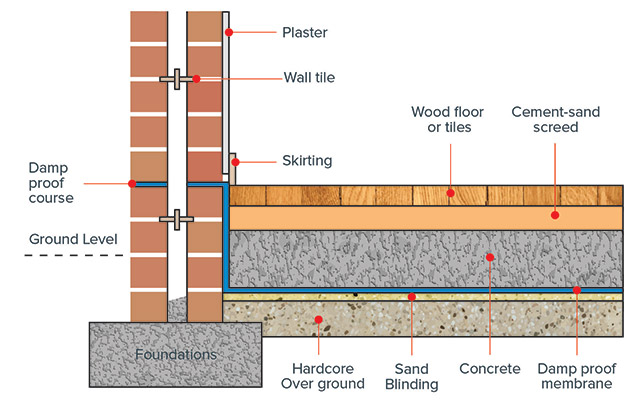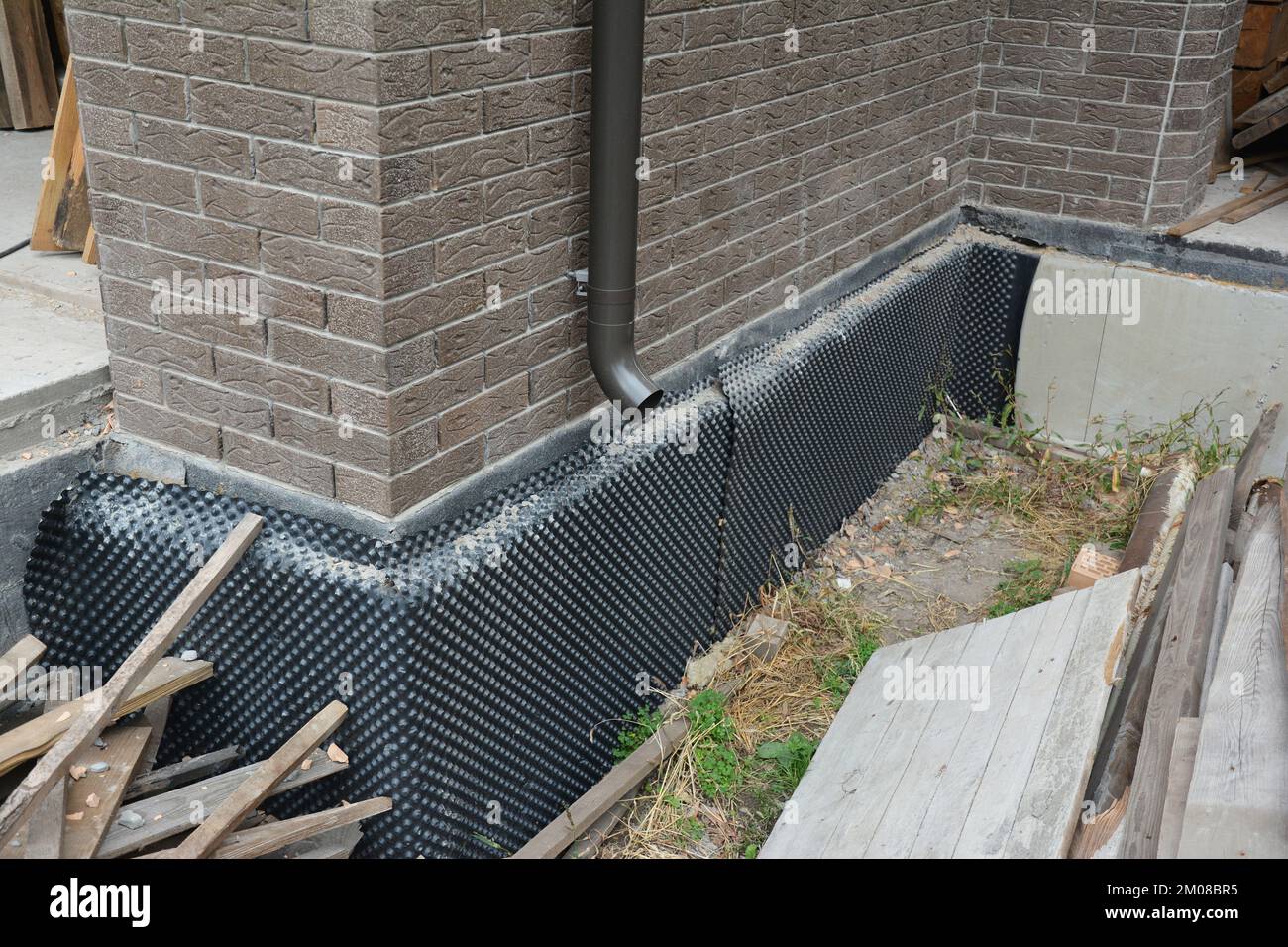Professional advice on dealing with rising damp from damp proofing newcastle
Professional advice on dealing with rising damp from damp proofing newcastle
Blog Article
Checking Out the Numerous Methods and Solutions for Effective Damp Proofing
Wetness in structures positions substantial challenges to both architectural honesty and indoor air high quality. Different strategies and solutions have actually emerged to battle this pervasive issue. From standard damp-proof membranes to ingenious chemical therapies, each method provides unique benefits. Comprehending these choices is important for effective wetness control. Nevertheless, picking the ideal option depends upon specific structure conditions and needs, prompting more exploration into the most effective damp proofing strategies readily available.
Understanding the Reasons of Moisture
Dampness can occur from numerous sources, understanding these causes is crucial for efficient removal. Frequently, moisture stems from 3 key sources: climbing wet, penetrating damp, and condensation. Increasing damp occurs when groundwater travels up through permeable materials, such as block or rock, often because of a lack of an effective obstacle (mould treatment newcastle). Permeating damp is commonly brought on by outside factors, including roofing leakages, defective gutters, or damaged wall surfaces, allowing water to penetrate a home. Condensation, on the other hand, arises from excess wetness in the air, commonly exacerbated by inadequate air flow and temperature level differences, resulting in water droplets basing on surface areas. Identifying these underlying concerns is essential, as each kind of moisture requires a tailored method for removal. Correct analysis assists in determining one of the most efficient options, ultimately safeguarding the architectural stability of a building and improving indoor air high quality
Standard Damp-Proof Membranes

Chemical Damp-Proofing Solutions
Chemical damp-proofing options supply a cutting-edge technique to avoid wetness invasion in structures. These methods usually include the application of liquid chemicals that pass through masonry and form a barrier against increasing moist. Commonly made use of chemicals include silanes, siloxanes, and other water-repellent representatives that respond with surface products to create a hydrophobic layer.The application procedure generally calls for drilling openings into the wall surfaces, infusing the chemical service, and permitting it to treat. This method is particularly beneficial for older structures where standard damp-proof membrane layers may be unwise. Moreover, chemical damp-proofing can be much less disruptive and more affordable than considerable restoration projects.While efficient, these options rely on proper application and environmental problems for peak efficiency. Normal maintenance and surveillance are important to assure the long life of the damp-proofing treatment. On the whole, chemical damp-proofing stands for a flexible option for securing buildings versus moisture-related damages
Cavity Wall Surface Building And Construction Strategies
Dental caries wall construction strategies provide numerous advantages, especially in dampness control and power efficiency. By incorporating an air void in between two layers of masonry, these wall surfaces efficiently alleviate water ingress while boosting insulation. This combination not only protects structures from moisture but likewise adds to lowered energy usage.
Benefits of Dental Caries Wall Surfaces
When thinking about reliable wet proofing approaches, the benefits of cavity wall surfaces stick out plainly. Dental caries wall surfaces include 2 separate layers, creating an air space that properly reduces moisture infiltration. This design minimizes the danger of moisture, as the external wall works as an obstacle versus rainfall and water access. In addition, dental caries wall surfaces boost thermal insulation, which adds to power performance by decreasing warm loss. They likewise provide audio insulation, assisting to develop a quieter interior setting. The air gap enables for air flow, which helps in dampness control and reduces the probability of mold development. These advantages not only enhance the overall convenience of a structure but likewise add to its longevity and structural integrity.
Moisture Control Methods
Effective wetness control techniques are crucial in dental caries wall building and construction to ensure lasting defense versus dampness. One key approach entails the unification of weep holes, which promote water drainage from the dental caries, stopping accumulation. Additionally, making use of breathable membranes can aid take care of wetness degrees while allowing trapped vapor to leave. Proper positioning of insulation is additionally crucial, as it ought to not obstruct water drainage paths. Ensuring that the outer leaves of the cavity wall surface are created with water-resistant products boosts total durability. Routine maintenance checks are important to identify any clogs or damage early, safeguarding the structure's honesty. Ultimately, a mix of these strategies forms a robust protection against wetness intrusion in cavity wall surfaces.
Insulation and Power Effectiveness
Insulation plays an important role in enhancing power performance within cavity wall surface construction. By incorporating insulating products, these wall surfaces produce a thermal barrier that reduces warm loss and minimizes energy consumption. Reliable insulation not just assists preserve a secure interior temperature but likewise alleviates the threat of wetness, as it prevents condensation within the wall surface tooth cavity. Various strategies, such as making use of stiff foam boards or mineral woollen, can be employed to attain ideal insulation performance. Furthermore, correct installment is necessary to ensure that voids and voids are decreased, which can otherwise endanger energy effectiveness. Inevitably, a well-insulated tooth cavity wall surface adds considerably to general sustainability and decreases cooling and heating expenses for home owners.
External Damp Proofing Approaches
External moist proofing approaches are important for protecting frameworks from moisture infiltration. Two efficient strategies consist of the application of waterproof membranes and the installment of French drains pipes. These solutions assist reduce water build-up and preserve the stability of buildings.
Waterproof Membrane Application
While numerous methods exist for stopping dampness ingress, the application of water-proof membranes remains a highly efficient exterior moist proofing strategy. These membrane layers are typically made from products such as polyethylene, rubber, or changed bitumen, offering a durable barrier against water infiltration. The installation process includes using the membrane to the external surfaces of walls or foundations, making certain total insurance coverage to stop leakages. Proper bond and securing at joints are essential to making the most of effectiveness. Waterproof membrane layers can be applied in various forms, including liquid layers and sheet membranes, enabling adaptability based upon the details demands of the structure. This approach not just shields buildings from moisture yet likewise boosts their durability and architectural honesty.
French Drainpipe Installment
One efficient method for handling groundwater and protecting against dampness accumulation around a building's structure is the installment of a French drain. This water drainage system includes a trench loaded with crushed rock and a perforated pipe that reroutes surface water far from the foundation. Correct installment needs mindful preparation, ensuring that the drainpipe slopes far from the framework to assist in suitable water circulation. Furthermore, the area of the drain is vital; it should be positioned in locations vulnerable to merging or excess moisture. Routine maintenance, including clearing particles from the crushed rock and ensuring the pipeline continues to be unobstructed, is essential for long-term effectiveness. Eventually, a well-installed French drain can significantly minimize the danger of water-related issues in structures and cellars.
Interior Waterproofing Approaches
Inside waterproofing strategies are vital for protecting a structure's inside from wetness seepage and potential water damages. These techniques generally entail the application of specific products and methods made to develop a dampness barrier within the framework. One common method is using waterproof layers or sealers on wall surfaces and floorings, which protect against moisture from penetrating surfaces.Additionally, mounting indoor drain systems, such as sump pumps, can successfully take care of water accumulation in cellars and creep rooms. Another method includes using vapor barriers, which are installed to hinder wetness activity from the ground right into living spaces.Moreover, addressing any kind of splits or voids in wall surfaces or foundations with proper sealers guarantees a comprehensive defense against water breach. By implementing these interior waterproofing techniques, homeowner can substantially reduce the risk of mold and mildew development, architectural damage, and other moisture-related concerns. Appropriate implementation of these techniques is vital for lasting security and building honesty.
Regular Upkeep and Inspection Practices
Regular upkeep and examination techniques are crucial for ensuring the long-lasting efficiency of moist proofing options in any kind of structure. Regular checks enable homeowner to determine very early indicators of moisture breach, such as peeling read more off paint, mold growth, and mildewy odors. These signs can signal underlying issues that need instant attention.Inspections ought to be performed at the very least every year, concentrating on prone areas like cellars, creep rooms, and exterior walls. Throughout these assessments, property proprietors need to check out sealants, drain systems, and air flow to verify they work correctly.Additionally, keeping downspouts and seamless gutters is essential, as clogged up systems can cause water accumulation near the structure. Carrying out a routine maintenance routine, along with timely repair work, can substantially extend the lifespan of moist proofing actions and secure the structural integrity of the building. Proactive actions eventually add to the total health and wellness and safety of the living environment.
Often Asked Questions
For How Long Does Damp Proofing Commonly Last?
The period of wet proofing performance differs, generally lasting between 20 to 50 years. Elements such as application top quality, environmental conditions, and maintenance methods substantially affect the durability of the damp proofing treatment.

Can I Damp Proof My Home Myself?
The private considered the usefulness of DIY damp proofing. With correct research and the ideal materials, it is possible. They additionally recognized the importance of expert support to assure durable effectiveness and avoid future issues.
What Are the Signs of Ineffective Damp Proofing?
Indications of inefficient damp proofing consist of persistent mildewy smells, visible mold development, peeling off paint, moist spots on walls, and wood decay - damp removal newcastle. Homeowners must attend to these problems without delay to avoid further damages and health worries
Does Damp Proofing Affect Indoor Air Top Quality?

Just How Much Does Professional Damp Proofing Expense?
Expert wet proofing costs vary significantly, generally varying from $1,000 to $5,000 depending upon the property's dimension, the extent of the wet problem, and chosen methods. Each circumstance needs a tailored analysis for precise rates. Frequently, wetness stems from 3 primary sources: increasing moist, penetrating damp, and condensation. When considering reliable moist proofing techniques, the advantages of tooth cavity walls stand out prominently. Exterior moist proofing methods are crucial for protecting frameworks from moisture seepage. While various techniques exist for preventing dampness access, the application of water resistant membranes remains a highly efficient external moist proofing method. Signs of inadequate moist proofing consist of relentless musty smells, noticeable mold development, peeling paint, damp spots on walls, and timber decay.
Report this page